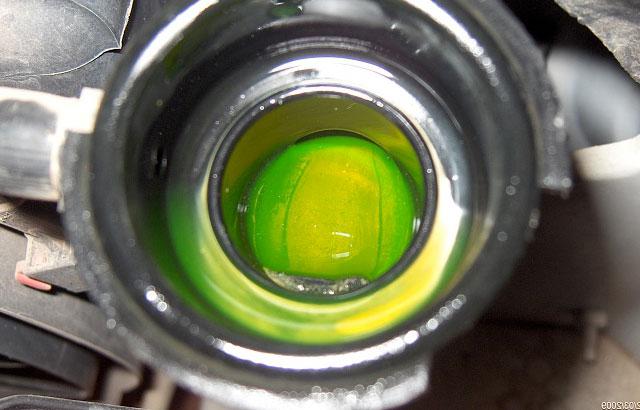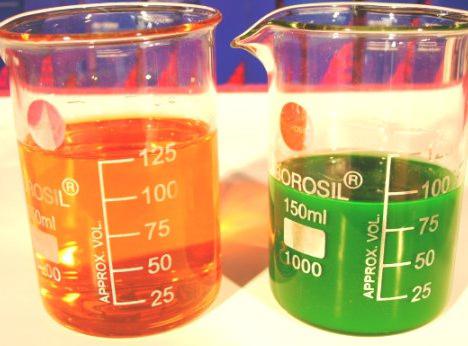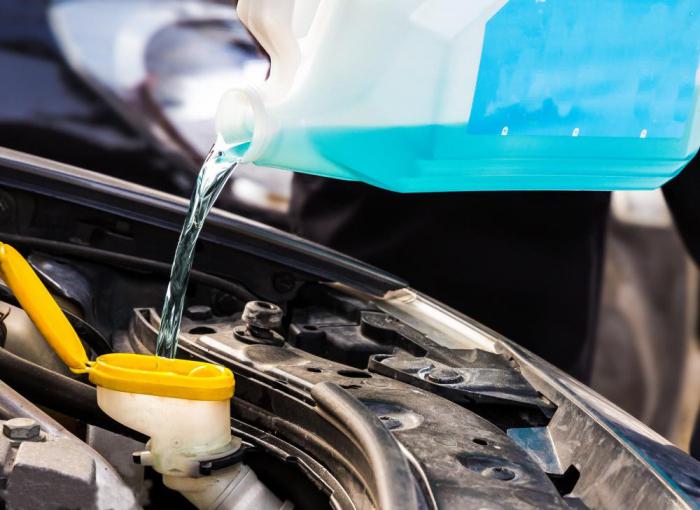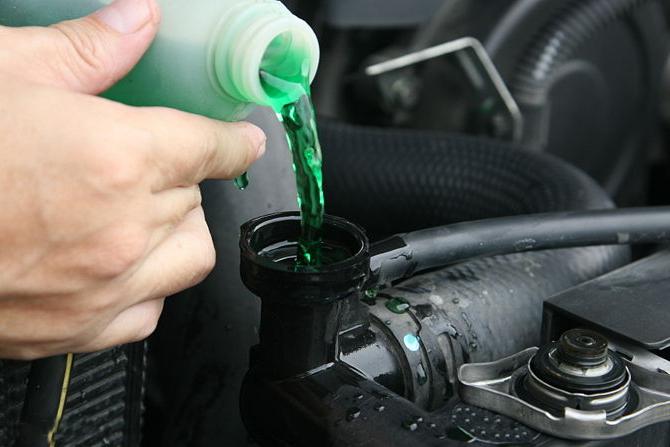What is better antifreeze or tosol? Is it possible to interfere with "Tosol" with antifreeze?
Very often, novice car enthusiasts not only do not give a special value of the car, but in general there are no idea that it is generally flooded in the case of their own car. Such an attitude frankly affects and discourages. After all, not only the technical condition of the machine depends on the right choice, but also your own health. Today we will talk about the better antifreeze or "Tosol" compared to each other.
Prehistory
In principle, such a dispute could occur only in our country, since only we practiced such a classification of this type of liquids. The fact is that Tososol is the same antifreeze, but Russian production. Because of this, many motorists with extreme alertness belong to its operational qualities, preferring not to upload this composition on expensive and high-quality cars.
Justice for the sake of saying that the risk of "running out" to the fake in this case and the truth is quite large, but foreign antifreeze fake a little less frequently. So the question itself is about the better antifreeze or Tosol, if you compare their quality, not too correct. It is stupid to compare the same liquid. You can change this topic somewhat: the better (or worse) the domestic cooling fluid compared to its foreign analogues?
To answer this question, you need to know theoretical part. Of course, it is impossible to learn everything about antifreeges and antiframes and tooslas from such a short material, but you can probably get the most important information.
General performance
As evidenced by almost all car experts, at least 20% of all cases of the engine breakdowns are associated with the coolant straight, and another 44% is indirectly. Therefore, the correct selection will help to maintain a lot of money, as the overhaul of the engine is an event that is difficult to rank with particularly cheap (especially under the current currency courses).
 As a rule, all coolant in their composition contains ethylene glycol compounds (very rarely propylene glycol), as well as water and a huge number of additives, the only purpose of which is the warning of corrosion processes. And here the dog "buried": the actual difference between the mixtures of different manufacturers is just in the sets and composition of additives that are used in the production of products.
As a rule, all coolant in their composition contains ethylene glycol compounds (very rarely propylene glycol), as well as water and a huge number of additives, the only purpose of which is the warning of corrosion processes. And here the dog "buried": the actual difference between the mixtures of different manufacturers is just in the sets and composition of additives that are used in the production of products.
In principle, it is them that make up the main commercial secret of manufacturers, since all properties selling products sold from these substances.
What should I navigate first?
To answer the question than the better antifreeze or "Tosol" for your car, it is important to familiarize yourself with the instructions or service book in which the manufacturer must give complete information about the preferred type of coolant and nuances of its use. Often Western companies indicate specific antifreeze brands that should be used in their cars. They passed the whole range of research and tests, and therefore guaranteed will not harm your car.
However, quite lyrics. It is important for us to find out the better antifreeze or Tosol, if you compare these liquids with each other. In order to answer this question, you should know that these compositions are produced in three different technologies.
- Traditional. In this case, additives created on the basis of inorganic acid salts are used (i.e. silicates, nitrites, nitrates, phosphates, etc.).
- Carboxylate (OAT). If you understand chemistry, then you will understand that in this case, in the contrary, organic acid salts (carbonates, to be more accurate).
- Hybrid. In this case, the coolant is created on the basis of a package of additives of organic origin, which contains a minor amount of silicates and / or phosphates.
So what antifreeze is better, why? But now we come to the most important thing. Domestic is produced according to the traditional scheme, while imported are made according to carboxylate technology. Accordingly, in order to deal with their strengths and weaknesses, similar characteristics of the compositions should be known. We will analyze eight main features that are manifested with the daily operation of the engine of any car. 
To interfere or not interfere?
By the way, is it possible to interfere with "Tosol" with antifreeze? If you carefully read the information set out above, then you yourself know the answer. No, it's not worth doing. Moreover: Look at the colors of various from different manufacturers. Another advice. Before changing antifreeze (or "Tosol"), rinse the engine with distilled water thoroughly. The new composition can be poured only after a perfect liquid will be flushed from the cooling system.
Mixtures even from one company, but having different color, it is not difficult to interfere. But even the compositions are from different manufacturers, but the same color, it is quite possible to top up one to another. Nothing catastrophic in this case will not happen. So you learned whether it is possible to interfere with Tosol with antifreeze.
Cooling fluid replacement procedure
It is always useful to repeat the coolant replacement procedure.
- We put the car so that its front part has a small slope down.
- Unscrew the plugs and drain the liquid into the ahead of the substituted container with a wide neck.
- The cooling system is washed with conventional distilled water into which it is desirable to add a special cleaning mixture. Water fill, tighten all covers and plugs. After that, it is necessary to start the car and on the full power to turn on the cabin heater. Give to work for at least ten minutes.
- The spent solution merges, the procedure is repeated two or three times.
- By 2/3 fill the antifreeze receiver with the composition and, leaving the stopper open, run the car engine. This will remove all air traffic jams from the system. We are waiting for all the same ten minutes, tighten the antifreeze to the required level, close the tank.
Engine cooling efficiency
 At first glance, the traditional technology is good because mechanically protects the metal from corrosion. How? These formulations form a layer with a thickness of up to 0.5 mm, which, axial on the surface of the parts, prevents the development of corrosion processes.
At first glance, the traditional technology is good because mechanically protects the metal from corrosion. How? These formulations form a layer with a thickness of up to 0.5 mm, which, axial on the surface of the parts, prevents the development of corrosion processes.
That's just the thermal conductivity of this film is so bad that the engine cooling can be reduced by 50%, which is not good. Simply put, the domestic "Tosol" can often act as a wonderful insulator! The engine begins to systematically overheat (although not critically), and this leads to its operation under the conditions to which it is purely technologically adapted. It flashes faster, sharply increases and power drops.
Carboxylate fluids in this respect are clearly leading. They also form a protective layer, but its thickness does not exceed 0.0006 mm (60 angstroms). This film practically does not affect the process of heat dissipation from the engine, and therefore it does not overheat. So better: antifreeze or "Tosol"? How to choose between two types of liquids, can you really navigate only on this characteristic? Of course not.
Deadline for the use of coolant
Specialists with confidence argue that in almost 90% of cases, if we are talking about domestic antifreeges, silicates and nitrites are used as additives. Silicates in this case are added to ensure the protection of aluminum, while nitrites are effectively operating against cavitation erosion.
Of course, the composition of the coolant is optimally balanced. But if it happens that some kind of component is spent, "Tosol" quickly loses all its properties, and therefore it does not protect the engine well from both overheating and corrosion. The fact is that due to high temperatures and other factors, silicates and nitrites are almost completely precipitated after 30-35 thousand mileage kilometers. Accordingly, the cooling fluid after this period all its properties loses almost completely.
 The liquids made on the basis of organic salts practically do not reduce their qualities throughout their operational period. Additives practically do not fall into the sediment, the solution throughout the entire period of use remains almost homogeneous. Thus, many foreign antifreeze can be normally operated for two years (at least 100 thousand mileage kilometers).
The liquids made on the basis of organic salts practically do not reduce their qualities throughout their operational period. Additives practically do not fall into the sediment, the solution throughout the entire period of use remains almost homogeneous. Thus, many foreign antifreeze can be normally operated for two years (at least 100 thousand mileage kilometers).
But! We warn the beginner motorists in advance that the replacement of the coolant ("antifreeze" or antifreeze) should be carried out in a timely manner, and not after the composition becomes something completely unsightly.
Aluminum protection and high temperatures and high loads
It is no secret that the modern automotive industry is becoming increasingly important to the use of aluminum and alloys based on it. In particular, even engines are made of these materials. It must be said that our coolant fluids are very poorly combined with aluminum, since they practically do not protect this substance from destruction under conditions of extreme temperatures and loads.
The researchers found out that at temperatures above 105 degrees on the Celsius scale "Tosol" practically cease to protect aluminum. Actually, because of this feature, it has not been used by manufacturers of all leading automotive brands for a long time.
On the contrary, carboxylast formulations in this area demonstrate the highest possible indicators. Experts, conducting numerous dynamic corrosion tests in various conditions, found out that high-quality antifreeze will exploit the engine of aluminum alloys by 45-60% longer.
Libid pump
It is known that the main cause of the exit of the liquid pump is hydrodynamic cavitation. Simply put, this is the formation of numerous gas bubbles in liquid and their rapid collapse in the working surfaces of the mechanism. As a result, materials are subjected to a real hydrodynamic attack, which contributes to the rapid destruction of the metal. Over time, cavities are formed, and the details are out of order.
In this case, I would like to recommend not "be conducted" on the proclamation of manufacturers. The laws of physics will not deceive, and therefore there is practically no difference between antifreeze and Tosol. No higher protection antifreeze in this case can provide.
Protection of engine sleeves from cavitation
 High-temperature cavitation is also exposed to car engines cylinders. In this case, it is better to "Tosol". We have already said that it forms a thick that much more efficiently prevents the destruction of the metal.
High-temperature cavitation is also exposed to car engines cylinders. In this case, it is better to "Tosol". We have already said that it forms a thick that much more efficiently prevents the destruction of the metal.
Stability of the composition and properties
Silicates, which are used in the production of Tosla, have an unpleasant wing to switch to the gel-like state. The phosphates, which also part of this type of cooling fluids, have a precipitate with the frequent heating and cooling cycles. Together with the gel, all this forms the "hellish mixture", which completely clogs the radiator and prevents the normal operation of the cooling engine cooling system. In contrast, fluids based on carboxylate compositions of such disadvantages are completely deprived.
Compatible with plastics and elastomers
In the cooling system of modern machines, plastic, elastomer, rubber and silicone elements are massively used. Carboxylate compounds do not have any negative impact on these materials. However, high-quality "Tosol" also does not destroy the rubber, plastic and silicone, so that in this respect the compositions are almost equal.
This is also evidenced by many years of research of domestic and foreign car manufacturers who could not identify any significant differences in this area.
So it is better: "Tosol" or antifreeze, and how to distinguish them? In general, everything is simple. For old cars with cast-iron engines there are no special difference. Perhaps, in this case, "Tosol" (at the expense of a low price). It is impossible to vision to distinguish these compositions, it is necessary to hope solely on the honesty of the manufacturer. Therefore, we recommend buying cooling fluids only in specialized stores.
There is nothing terrible to use instead of antifreeze "Tosol", but overpay for a cheap liquid selling under the guise of more expensive is always unpleasant.
SOME DIFFERATION METHODS
However, some methods still have. So, some "specialists" advise to try the composition for taste: it is believed that "Tosol" is sweet, as there are many ethylene glycol in its composition. That's just to use this way, we would ultimately not advised, since all the fluids for cooling the engine are poisonous (to one degree or another). How else can you distinguish "Tosol" or antifreeze? How to find out what is flooded in the tank?
If you have the opportunity to pour a small amount of the composition in some kind of ass, do it and look at the process: on its "texture" "Tosol" looks more like vegetable oil, while antifreeze looks more likely to conventional water. Remember that the color of the composition does not mean anything, as it depends only from dyes that can be added any (than the sellers of fake products).
Thus, in most cases antifreeze leads. This is especially true for new cars that have been released in the past few years. So we practically answered the question of what is better: "Tosol" or antifreeze (and why). It remains to clarify a few small details.
Caring for ecology
 Here carboxylast formulations show the best results. And the point here is not so much in their chemical composition, but in banal logic. It is necessary to change them much less often, and therefore harm to the environment is applied noticeably less. Finally, yes, in terms of chemistry, carboxylate mixtures are still much better, since they are easier to dispose of them, so that they did not harm the ecology.
Here carboxylast formulations show the best results. And the point here is not so much in their chemical composition, but in banal logic. It is necessary to change them much less often, and therefore harm to the environment is applied noticeably less. Finally, yes, in terms of chemistry, carboxylate mixtures are still much better, since they are easier to dispose of them, so that they did not harm the ecology.
Here you learned that it is better: antifreeze or "Tosol", it is possible to interfere with these mixes, what are their characteristics. We hope that our recommendations were useful for you.










